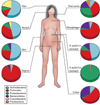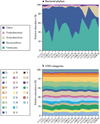The human microbiome: at the interface of health and disease
- PMID: 22411464
- PMCID: PMC3418802
- DOI: 10.1038/nrg3182
The human microbiome: at the interface of health and disease
Abstract
Interest in the role of the microbiome in human health has burgeoned over the past decade with the advent of new technologies for interrogating complex microbial communities. The large-scale dynamics of the microbiome can be described by many of the tools and observations used in the study of population ecology. Deciphering the metagenome and its aggregate genetic information can also be used to understand the functional properties of the microbial community. Both the microbiome and metagenome probably have important functions in health and disease; their exploration is a frontier in human genetics.
Figures



References
-
- Baumann P, Moran NA. Non-cultivable microorganisms from symbiotic associations of insects and other hosts. Antonie van Leeuwenhoek. 1997;72:39–48. - PubMed
-
- Ehrlich SD. MetaHIT : The European Union Project on Metagenomics of the Human Intestinal Tract. In: Nelson KE, editor. Metagenomics of the Human Body. Springer; 2011. pp. 307–316.
-
-
Ravel J, et al. Vaginal microbiome of reproductive-age women. Proceedings of the National Academy of Sciences of the United States of America. 2011;108 Suppl 1:4680–4687. Describes vaginal microbiome differences and similarities in women of reproductive age who vary by ethnicity, and explores factors related to bacterial vaginosis
-
-
-
Arumugam M, et al. Enterotypes of the human gut microbiome. Nature. 2011;473:174–180. Proposes enterotype classifications that are defined by the intrinsic characteristics of the gut microbiome, and that seem to be independent of ethnic or dietary factors
-
Publication types
MeSH terms
Grants and funding
LinkOut - more resources
Full Text Sources
Other Literature Sources
Medical
Miscellaneous

